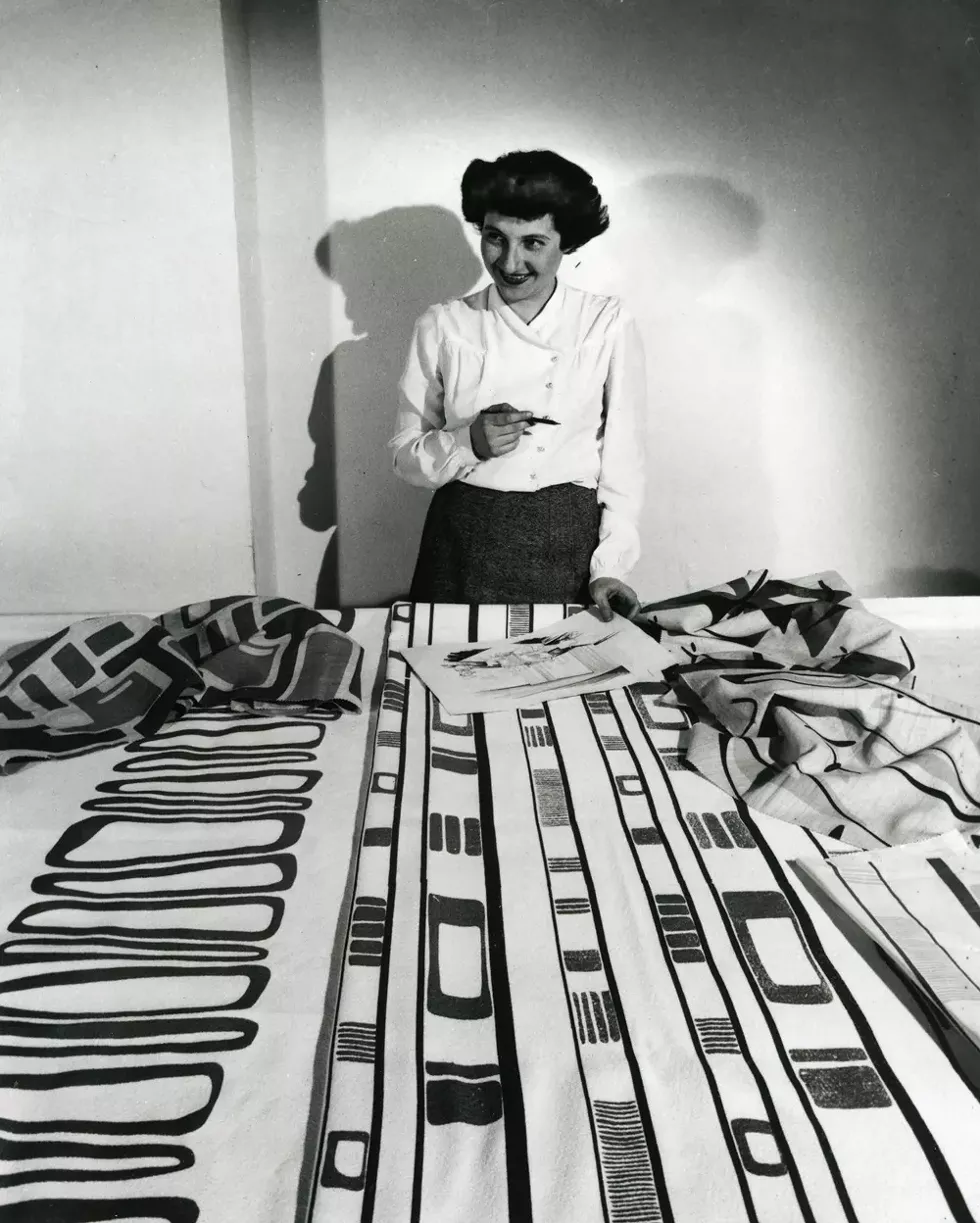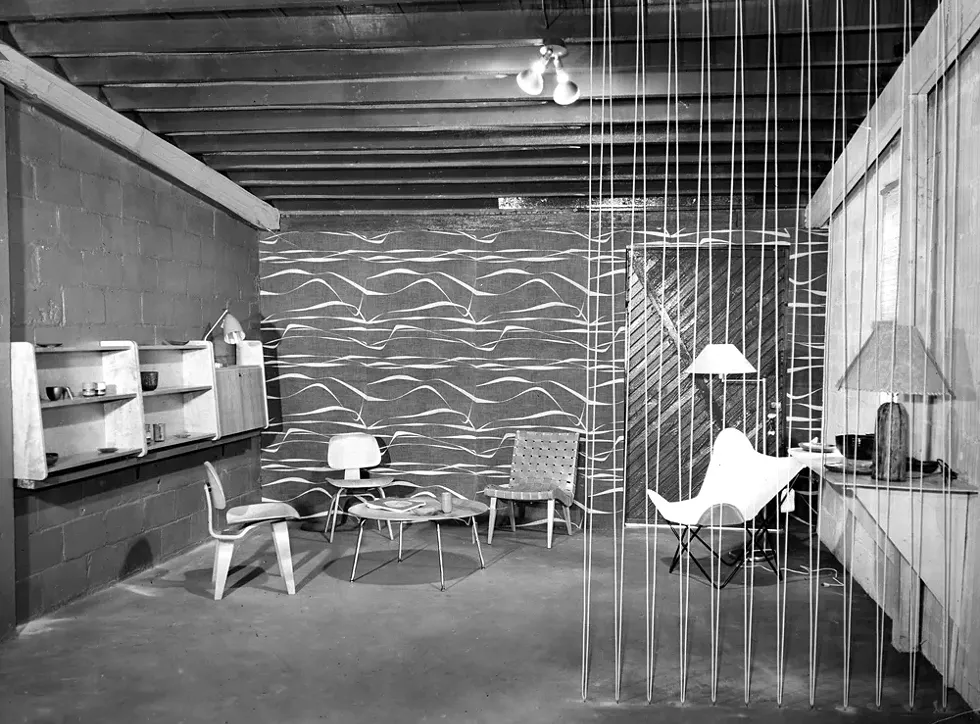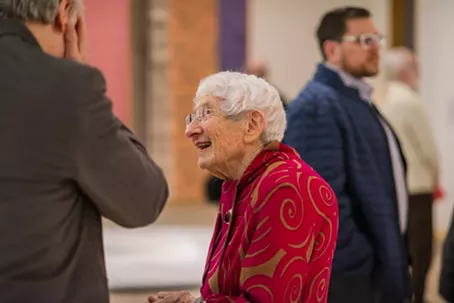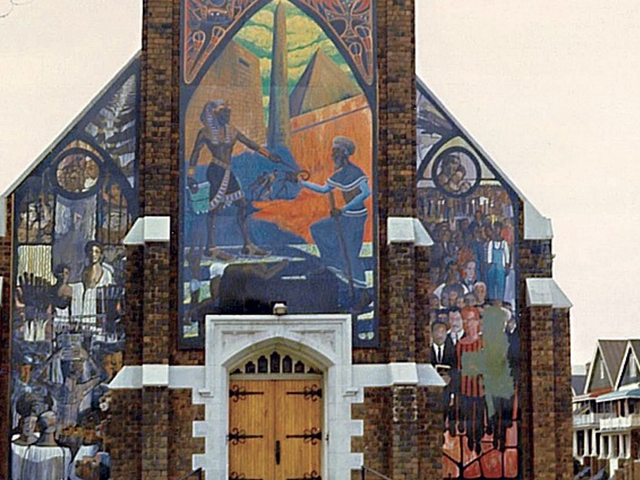"I just loved what I was doing, and I wasn't scared," 96-year-old textile artist and interior planner Ruth Adler Schnee says when asked about the time she went to the showing of the Degenerate Art Exhibition in Düsseldorf, held by the Nazis as Hitler came to power and Kristallnacht was on the horizon. Adler Schnee was 14, Jewish, obsessed with modern art, and desperate to attend the exhibit.
"My parents absolutely did not want me to go to that exhibit," she says. "I was a noodge. You know what a noodge is?" I don't, and I say so.
"One who doesn't stop mentioning the things she wants to do," Adler Schnee says with a laugh. "And I very much wanted to do that. They were examining people, and of course, there was incredible anti-Semitism, so they could've put me in jail. But that never crossed my mind."
The exhibit was supposed to back up the Nazis' claim that modern art was degrading German culture. But the effect on young Adler Schnee was very much the opposite. "Once I got to see the art, I was beside myself," she recalled in an oral history conducted by her daughter Anita Schnee back in 2003. "I had never seen colors so brilliant and so unusually put together as in the Kandinsky paintings. It was as though I had been introduced to a new world. And I came home just totally transported by that."
Color has been instrumental in Adler Schnee's life. Her mother was a student of the foundational modernist German art school Bauhaus. Swiss painter Paul Klee, who also taught there, was a family friend. Her background was unusually positioned toward art at an extremely young age. She took to it with great pleasure, designing her own clothes as early as age 4. On her first day of school, she wore a brilliant yellow sweater her mother had knitted specifically for the occasion. When her teacher saw her come through the door, she raised her arms and said, "Ah, now comes the radiant sun."
Adler Schnee's radiance has never dimmed. Now we get to experience the first full reckoning of her design career with an exhaustive exhibit at Cranbrook Art Museum. It includes everything from the screenprinted mid-century patterns she designed in the '40s and '50s to the revitalized woven forms of those designs in the '90s — the work she is best known for in our current era — to more obscure items like a variety of one-off custom rugs she created, as well as printed material, including photos and advertisements related to Adler-Schnee Associates, the retail business she and her husband, Eddie, ran together.
Adler Schnee herself may be slight in stature, but nothing else in her life could be described that way. One glance through the exhibit immediately makes that evident. Much like her work, Adler Schnee is magnificent, colorful, brave, pioneering, uncompromising, steadfast, and true — a vibrant storyteller conversationally and artistically. One of the last living figures of the mid-century modern design movement.
A style connected to ideas of democratic design, mid-century modern placed emphasis on function as much as form and organic shapes. It was influenced in equal measure by the International Style, a modernist form of architecture that was developed in the 1920s and 1930s, and the modernist principles of the Bauhaus movement, named for the prestigious German art school that incubated it.
Adler Schnee herself may be slight in stature, but nothing else in her life could be described that way.
tweet this
Adler Schnee's family persevered through the escalating persecution of Jews in Germany; when her father was detained and then interned at the Dachau concentration camp, her mother worked tirelessly to get him released and, somewhat miraculously, was successful. The family secured a trip to the United States and set about rebuilding their lives in metro Detroit. Adler Schnee eventually went to Cass Technical High School to study fashion. On the strength of this work, she got a full scholarship to the Rhode Island School of Design for fashion, but switched to interior design early in her studies. She was interested in modern architecture and eventually landed a job with Raymond Loewy, who is now sometimes known as the Father of Industrial Design. Adler Schnee worked there long enough to create lasting relationships with architects Warren Platner and Minoru Yamasaki, the latter of whom designed the original World Trade Center, with colors for the lobby specified by none other than Ruth Adler Schnee.
Adler Schne was quite happy at work in New York, but was persuaded to return to Michigan after Cranbrook awarded her a fellowship in the design department. She was one of the first Jewish women to receive this honor, as well as one of the first women to graduate from Cranbrook with an MFA in Design. "When I studied architecture, the field was not open to women," Adler Schnee says. "And I found myself, all the time, to be the only one that was interested in that. But that didn't seem to stop me."
Oddly enough, Adler Schnee's path toward textiles was shaped by sheer happenstance, a byproduct of the fact that there were no drapes on the market that were modern enough for her vision when she was working on her entry for the Chicago Tribune's Better Rooms for Better Living residential design competition. She imagined her own and drew them in. When this design won, Adler Schnee heard from an architectural firm interested in purchasing the drapes. When they found out the drapes didn't exist, the firm offered Adler Schnee a deposit to bring them to life.
She had taken a class or two on textiles, but it was by no means a focus of her studies at Cranbrook. There she had leaned toward architecture and interiors, color planning, working with light and shadow, and how all elements of space interacted with one another. But with the support of the firm who wanted her drapes, opening her own design studio and screenprinting workshop seemed to make perfect sense. It was 1947, and Adler Schnee was only 24 years old.
Adler Schnee talked about this first studio, which was on 12th Street in the heart of Boston-Edison, with her daughter Anita back in 2003. "The front was open to the public," she said. "Word got around that I had this little shop, and people came by. I felt I should have something in the front window, so I purchased an Eames chair, a little Knoll table, and I had a friend who was a potter in Vermont — Nancy Wickham, who supplied the most beautiful pots."
When her husband, Edward Schnee, came on, the two continued the printing business on 12th Street and rented the garage in back. "People had to go through the alley, which was strewn with garbage and beer cans, to get to that garage, which Eddie painted green," Adler Schnee says. "He did it after shop hours. He would come home totally covered in green paint, his shoes, everything. He sprayed the walls green. We displayed fine crystal there. I don't know to this day how people got back through that alley."
Edward Schnee was Ruth's one true love and a fountain of support. "I had a wonderful husband who didn't mind spending hours talking about good design and why we liked it and why it was important to have it around you," Adler Schnee says. This was particularly important when it came to running the retail side of their business, Adler-Schnee Associates. In the store, they sold Adler Schnee's own designs, as well as a number of highly curated modernist pieces of home décor.
Eddie had a degree in accounting from Yale, but after marrying he settled into the business role of Adler-Schnee Associates, making sure their finances were in order, as well as chasing the perfect modernist pieces across the country. He was totally convinced of the value and beauty of this aesthetic, so much so that he forked over more than they could really afford for an Eames wood-laminated screen, then priced at $275. It stood in their show window, undesired by the general population, for two years, and was eventually donated to a public radio station. Much later, Adler Schnee learned it had been auctioned off for $4,500.
Art historian Deborah Kawsky met Adler Schnee in 2011 when she began researching an Alexander Girard-designed home that had recently been re-discovered in Grosse Pointe. (This work would later be published in Kawsky's first book, Alexander Girard, Architect: Creating Midcentury Modern Masterpieces.) An architect and designer particularly well-known for his colorful fabrics and deep-rooted interest in folk art, Girard was instrumental in the visual cues of mid-century modern. Adler Schne had worked with him on the iconic For Modern Living exhibition held at the Detroit Institute of Arts in 1949, which displayed the work of many of the modernist figures whose careers Adler Schnee crossed paths with, including Yamasaki, groundbreaking architect and furniture designer Charles Eames, and neo-futuristic designer Eero Saarinen — son of Eliel Saarinen, who designed the Cranbrook campus and became president of the Cranbrook Academy of Art.
Working together on this project led to a deeper collaboration between the two women that turned into a friendship as they criss-crossed the country attending openings and giving lectures. "We were design partners on the road," Kawsky says, an experience that has given her a unique perspective on Adler Schnee's understated role in this design movement.
Even though Adler Schnee's textiles are designed in two dimensions — "I am totally uninterested in computers and the new world," she says, and has always only used her pencil and the T-square — she was always thinking in three dimensions, according to Kawsky. This comes from the foundational design philosophy taught at Cranbrook, a concept that essentially boiled down to the importance of the aesthetic unity of total design. Patterns, colors, textures, furnishings — everything had a necessary role to play in the larger architectural environment of a space.
"When people view her textiles, they're always talking about this pure aesthetic pleasure that they find in them," Kawsky says. "Of course, she has these characteristic bold colors and patterns and the playful names that were conceived by Eddie. But that pleasure is not at all reflected in her own experience as a designer. She describes the design process as pure agony."
Adler Schnee could spend several years on some designs, reworking until she was satisfied to the best degree. How did she know when a design was finished? "Well, you'll probably laugh at this, but somehow it sings to me," she says. She laughs when I tell her I find that wonderful, but it even makes a kind of aesthetic sense; some of her patterns have a decidedly musical quality to their appearance.
The agony of the process also goes back to her training at Cranbrook. Kawsky explains: "Eliel Saarinen had this dictum: art and design cannot be taught. It must be learned. They didn't tell you what to do; they put you in a studio and said 'Create.' She said it was lonely and terrifying at first, but it was ultimately rewarding because it instilled in her this personal and professional discipline."
When asked now about what inspires her, Adler Schnee thinks for a moment and simply says, "Everything."
"She's pulling almost exclusively from landscape and space," exhibition curator Ian Gabriel Wilson says. "The built landscape and the natural landscape." Biomorphism is a fancy way to refer to this artistic element, which evokes nature through abstract patterns and shapes.
When asked now about what inspires her, Adler Schnee thinks for a moment and simply says, ‘Everything.’
tweet this
An early biomorphic pattern known as "Germination" was conceived on Adler Schnee's honeymoon in the Southwest, inspired by the striations in the hilly landscape. Patterns like "Central Park South," "Country Fair," and "Spiney Pines" all clearly evoke environments. Eddie's humor in naming her work is on display with "Bugs in Booby Traps," an odd visual pairing of chopped triangles and balloon-animal-circles that does, indeed, suggest trapped bugs.
Adler-Schnee Associates moved four times. The initial studio was relocated to a larger spot on Puritan Avenue, then moved to the Avenue of Fashion on Livernois. Adler Schnee recalls that the students of U of D's architectural department were always in and out, given that the campus was right down the street. "They had very little money so they were not the best customers that we had, but they were certainly loyal," Adler Schnee says with a laugh.
The final move was to Detroit's Harmonie Park, made possible by Eddie's remarkable ability to convince local retail giant Hudson's to invest in their tiny little store using a "David and Goliath" marketing angle. Somehow it worked. Hudson's got a tax write-off, and Adler Schnee and Eddie got their downtown store. The store stayed there until 1976 when it closed its physical doors. (The business lived on with interior planning and consulting projects, among other things.)
Adler Schnee stopped creating new textile designs in the '60s, but by the time the '90s rolled around, the world was starting to come around to the colorful promises of mid-century modern. She was approached by textile firms to bring some of her original designs back to life, as well as create new ones. Museums started noticing and exhibiting her work. 2010 brought a documentary, The Radiant Sun: Designer Ruth Adler Schnee. In 2015, she was named a Kresge Eminent Artist and signed a 20-year-contract with Knoll Textiles. This year, Adler Schnee's life and career are the subject of a new book, Ruth Adler Schnee: Modern Designs for Living, the comprehensive companion piece to the Cranbrook exhibit.
In 1946, in her thesis at Cranbrook, Adler Schnee wrote, "The new is now." Somehow, the spirit of this sentiment seems not to have faded at all in the intervening years. "There is no reason to fight for acknowledgement of contemporary design," she wrote. "We are ready to accept it." It may have taken longer than anticipated, but for Adler Schnee's forward-thinking vision, her embrace of modernity and color, its brilliance and light, acceptance has undeniably arrived.
Ruth Adler Schnee: Modern Designs for Living is on view at the Cranbrook Art Museum through March 15. You can hear Deborah Kawsky speak at 2 p.m. on Sunday, March 1, at the Cranbrook Art Museum deSalle Auditorium; 39221 Woodward Ave., Bloomfield Hills; 248-645-3323; cranbrookartmuseum.org. Lecture is free and open to the public, museum admission is $10.
Get our top picks for the best events in Detroit every Thursday morning. Sign up for our events newsletter.








